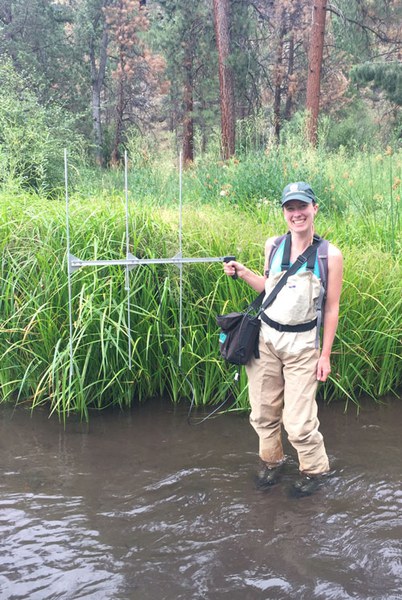“I’m going hunting for fish tomorrow,” I told my husband after work one evening. “Don’t you mean you’re going fishing,” he responded. But that’s not what I meant. There was no rod and reel involved. I was searching for Chinook salmon that had returned from the ocean to Whychus Creek.
This year has shaped up as one of the best years so far for returns of reintroduced spring Chinook salmon that originated in the Deschutes River. Back in June, we reported that several tagged Chinook had returned for the first time to Land Trust protected lands along Whychus Creek. Then in August, Portland General Electric (PGE) radio tracked an additional three tagged Chinook at Whychus Canyon Preserve, one at Aspen Hollow Preserve, and one at the Land Trust protected Rimrock Ranch. A week later, I headed to Whychus Canyon Preserve with a fish technician and a fish biologist from PGE in order to, you guessed it, search for fish. It was time to get visual confirmation of these Chinook.
Let me start by saying that I am not a scientist. Far from it. I have a bachelor’s degree in Journalism and my last science class was Intro to Environmental Science while completing requisite coursework during my freshman year of college. However, I find science and the natural world fascinating and consider myself lucky that I get to work with scientists, biologists, and other experts. Heading down to Whychus Canyon Preserve with two cameras (and a request for some video footage), I figured we’d easily find the fish, snap a couple photos of them, and be on our way. That is not how it turned out.
Moving through the restoration area at Whychus Canyon Preserve, the radio was telling us that two Chinook were hanging out in a calm pool. Terry posted up at the top of the pool while I stationed myself at the bottom of the pool. If the fish got scared and swam upstream or downstream, we’d see it. I had my camera set to continuous shoot mode--if I saw movement in the water, I was pressing down on my camera shutter and not letting go until the fish had swam far away. Jaym’e donned her snorkel and started the slow, methodical search for the fish.
Nothing.
Terry confirmed the radio was telling us this was the right spot. Jaym’e searched again. This time, she saw a brief flash of an adult fish tail before it swam under a log. Was this one of the Chinook? Jaym'e was 95% sure. She continued to focus on the area around the log and got another brief flash of an adult fish before we decided to move on. Confirming the two fish via mobile tracking (but not 100% visual confirmation) was all that we were going to get. It turns out there’s a reason these fish had survived the predators of the ocean, swam up the Columbia River, snuck past predators on the Deschutes River, and then made it to Whychus Creek. They were good at hiding.
As a rare summer rain slowly began, we walked upstream to locate one final fish. Number 102. Here was our last chance to 100% confirm a fish for the day. I had lots of photos of Jaym’e floating in Whychus Creek and many photos of Terry with the radio antennae, even a photo of me operating the radio, but no photos of fish.
We honed in on 102’s location with the radio antennae. A deep pool. Big rocks on the side. A couple logs. Lots of hiding places for a fish. 102 was not going to make this easy. Jaym’e took a first pass over the area. As she floated next to a rock in the middle of the creek, she gave a thumb’s up. A THUMB’S UP! She stayed there for a few more seconds before slowly letting the creek’s current float her downstream until she was further away. Standing up, she shouted, “I saw it! I even saw its radio antennae and its Floy tag!” We’d done it! Visual confirmation!
It might not seem like much, but we were all excited! We’d just spent the last 3 hours trying to 100% visually confirm one of the tagged fish, and with the last fish, we’d seen it! Jaym’e went back to look at it again, but alas, the fish had swum away, moving on to a better hiding spot.
I might not have ended up with any photos of fish. But I got to learn a little more about fish conservation, how restoration efforts of Whychus Creek are improving fish habitat, and how good Chinook are at hiding.
Learn more:
- Wood is Good: The Importance of Woody Debris in Streams
- The Importance of Meadows
- The Life and Times of Stella the Steelhead


